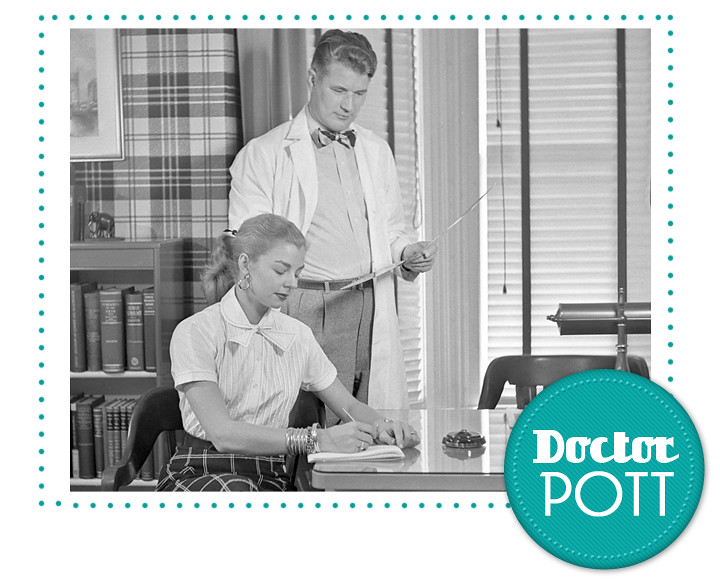
Joey's Mom worked as an assistant to their local doctor, Dr. Pott. She tells how she got the job and details some of the adventures below. Please note that you can click the photo to view them larger on Flickr.
Jerry felt strongly about patronizing businesses in our neighborhood. So it is that we patronized the new doctor who set up his office nearby upon his return from World War II duty. His office building was a former residence in the Italian villa style — very similar to Jerry's Barclay Street house. It was just three doors east of Jerry's business and five or six doors from our apartment above the Unclaimed Freight Store.
A few months after settling into marriage, a commotion on the street below our apartment sent me to the front bay windows. I saw the aftermath of a collision, the arrival of police, bystanders clearing the way for the doctor carrying his black bag, traffic backing up on the business street (which was also a state trunkline), and folks running up to gape. I didn't recognize the doctor. It was not unusual that he was summoned because his office was nearby, and emergency rooms weren't part of the culture to the extent they are now. Of course no one had a cell phone to call for an ambulance either. A good thing. They were often owned by funeral directors.
On a later day the doctor knocked at our apartment door at mid-morning. "Remember me? Dr. Pott? I did your marriage blood tests." He said my husband approved his asking me to mind his telephone that day as his assistant hadn't appeared and he was swamped.
A day's tryout turned into years. In fact, my job with Dr. Pott roughly coincided with my marriage to Jerry. I think Jerry snapped this photo after work one day when I showed the office to him and pretended to receive a call.
Work began easily, with ample time to treat each of the neighborhood patients with care. The charge was almost always $3, and nearly everyone paid in cash. Dr. Pott always had a fat roll of one dollar bills in his pocket. Those who "charged" received a statement in the mail, which I hand-typed on a small portable typewriter at the beginning of each month.
The doctor taught me how to give injections, take blood pressure, assist with minor office surgery, give diathermy treatments, take basal metabolism tests, do urine analysis tests for sugar and albumin. Most patients appeared with a bottle of urine and all was faithfully tested; patients would telephone the next day for a report.
In spare moments Q-tips and swabs were handmade, bandages prepared, the rubber gloves were powdered. The regular routine upon arrival in the morning was to sterilize the needles, syringes, and any instruments from the day before and boil the used rubber gloves. Little was disposable at that time. As the test tubes of urine bubbled, I would do a quick dusting of the waiting room and doctor's desk, arrange the magazines Mrs. Pott had sent over (The New Yorker and House Beautiful), then vacuum through all of the rooms pulling a bullet-shaped Electrolux. Everything would be ready when the doctor arrived at 10, smelling of ether from doing morning surgery.
During the first years we didn't do appointments, and patients simply waited their turn. The waiting room was the large living room of the former residence, furnished with chairs all around.
In the early days there were periods when no one was waiting, and Dr. Pott and I had time to chat. Our favorite topic was the patients. We saw them until 5 every day, plus Monday and Wednesday evenings and Saturday mornings. The doctor made home visits after office hours. If he needed my assistance on a house call he would schedule it for Saturday afternoon when the office was closed.
Some of our patients enjoyed going to the doctor; they kept a regular bill going and dropped by periodically to pay on it in cash, usually $1 bills. They felt a real friendship with the doctor, and we with them. It was a social occasion for them, and they were also keeping themselves tuned up.
Of course the doctor treated serious conditions of all kinds: cancer, gall-bladder disease, diabetes, heart problems, syphilis. If appendicitis were diagnosed, the doctor hurried to the hospital behind the patient. Folks injured in nearby auto accidents were brought in from the street for stitches and bandages. A diagnosis of pregnancy eventually resulted in the delivery of a baby.
The job had many attractive features, and one was being able to wear a uniform. It meant no daily panic over costume choice, and much less drain on the budget. I didn't like practical "nurse shoes" however, and the doctor never complained that I substituted high-heeled white pumps. I was on my feet all day. No wonder I have problems now.
The good-looking doc decorates this room as much as the handsome wallpaper and furnishings selected by Mrs. Pott. The loveseat he occupies here in his office at mid-century is lipstick red.
The heavy black bag was the doctor's icon. When opened and unfolded, a plethora of pills and treatment devices was revealed. Upon entering the office, the doctor's first act was personally replenishing his bag. Then he would don his "office shoes" for a long day on his feet. This worn pair must have been super-comfortable. Patient after patient presented their problems at intervals averaging 12 minutes, I once calculated. I marveled at his concern for each, his stamina, and his unflappability. When he left the office the shoes were kicked off and the black bag went home with him. He was never without it outside the office.
While the Potts were in Amsterdam, I mailed this still life to him at his kinfolks'. He told me it was a great hit, and he seemed really pleased.
In 1952 the doctor and his wife went to Europe for a month.
I kept regular office hours during Dr. Pott's summer away. I earned my keep by refilling medicines, taking blood pressures and performing other routine procedures. Allergy shots could be continued on schedule and weight-loss patients assessed and re-supplied with their amphetamine fixes. (Yes, in common use at the time! I worked there long enough to observe that, though it didn't work long-term.) Young Dr. Humphrey came in on certain days for patients requiring heavy-duty treatment.
We planned a re-do of his medicine room that summer during his absence. Carpenters built new cupboards, and I sanded and painted them.
The many, many plywood doors and drawers had to be sanded and painted three times. I was not a beer drinker, but on this hot day it's no wonder I sank into a corner with a cold beer “borrowed” from the stash of Miller’s High Life that I left for the carpenters in our little office refrigerator.
The floor and backsplash of black marbleized linoleum was a style of the times, and practical, we hoped. The chrome finishing strip on the counter’s edge was of that era too.
The carpenters, Bob and Roland Wysorek, were a joy, as neat and precise in their work as they appeared themselves.
Our medicine room had been the kitchen of a two-story brick Italianate residence built in the late 1800s on East Fulton Street in Grand Rapids, Michigan. The original kitchen had one wall of cupboards; a roll-rim sink hung on another. The old cupboards were filled with bottled pills and gallon-size bottles of liquid medicine. The drawers were stuffed with medicine samples bestowed by salesmen. Injectables and drugs were kept in the metal cabinet with a glass door that could be locked, but never was. Although in full view of the windows, we never worried about a break-in.
The Bunsen burner on the counter held test tubes of urine that were cooked to detect albumin. Gas to power the burner came from a line formerly leading to the kitchen range. The original counter had been crudely constructed to get the office up and running when the doctor came home from his WWII Army duty and began his practice. Now Bob and Roland would replace it with a real counter and cupboards above and below.
The upward-tilted dowels on the board above the sink were used to hang rubber gloves to dry after being boiled. Disposable gloves were not in general use yet.
The doctor's microscope was mounted on the small square table, with an electric bulb underneath shining light upward.
A large map of the city hung just above the chair near the back door. I well remember Dr. Pott consulting it before heading out on house calls in those pre-OnStar days.
The doctor encouraged me to turn the adjoining bathroom into my darkroom, where I spent many Saturday afternoon hours. Sometimes my photographic tools mingled with the tools of the doctor. The black roller hanging above the sink is a print roller. After laying my freshly washed prints on ferrotype plates, I rolled them to create a glossy surface.
Jamie here! Medicine has changed so much in the past 60 years, hasn't it? I am purposefully leaving off with a tease about Joey's Mom's dark room because that will be the subject of next week's post! :) Stay tuned!
If you're new to Owl Really, welcome! Please check out my favorite posts and consider subscribing! :)

















another great installment! Not only has medicine changed, but everything else. The map? now gps
ReplyDeleteLife must have been so laid back during that time. Happy that Joey's mom shared that the loveseat was RED, that surprised me.